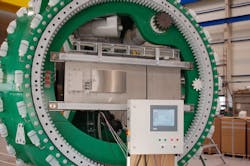OPC UA Opens a World of Applications
As one of the world leading manufacturers of injection molding machines, Arburg is continuously on the lookout for possibilities to improve efficiency. Among the key requirements of its customers are easy installation, commissioning and maintenance. Vertical integration, configuration, visualization and diagnostics of the injection molding machines in higher-level applications also play a major role.
Based on Softing's OPC UA Toolkit, Arburg has developed an embedded OPC UA server that is integrated into the injection molding machine, preinstalled and preconfigured, and thus eliminates the need for on-site installation at the customer's location. As the Arburg injection molding machines are based on the VxWorks operating system, this solution would not have been possible with Classic OPC technology. The use of additional Windows PCs would have been necessary instead.
Another advantage of the Arburg solution is the scalable namespace, which in OPC UA can be restricted to the required subset, according to the size of the machine. Heinrich Müller, Head of Software Development at Arburg, points out the advantages of the implemented solution: “For us, as manufacturers of injection molding machines, the OPC Unified Architecture provides an easy and convenient way to integrate our machines into higher-level applications. OPC UA also makes it very simple for our customers to configure, monitor and analyze data in our injection molding machines,” notes Müller. “Using the Softing OPC UA Toolkit, we saved several months of development time. The performance, stability and quality of Softing's OPC UA software are excellent.”
Energy monitoring via the Internet
The Austrian company nte Systems was founded in 2009 with the objective to set up a technology enterprise with an industrial character, specializing in renewable energy systems. nte Systems offers processes, methods and diagnostic systems for the use and operation of renewable energy systems, and complements the portfolio with innovative electronics and software products. In a large residential complex in Graz, Austria, nte Systems has implemented the operation and monitoring functionalities for the entire local heating grid of several buildings, for the heating system for 59 residential units, and for a 300 sq.m solar thermal system.
PLCs from Beckhoff Automation with integrated OPC UA server are used for controlling. Operation and monitoring is performed centrally through the Scady product from nte Systems, while OPC UA software from Softing is used for communication over the Internet. (See photo.) “After we had connected the PLC to the Internet, all the data items were visible in the Scady System Designer as soon as we entered the IP address. We could then make up the complete visualization by drag-and-drop. It couldn't be any simpler,” says Georg Stasny, Managing Director of nte Systems. As Andreas Hafellner sums up: “Only OPC UA gave us the possibility to implement for the end customer a 'no programming' remote control and monitoring platform for PLC data over the Internet. With OPC and COM or similar predecessor technologies, the secure connection across firewalls and the secure connection to several hundred OPC servers simultaneously would have been impossible or at least extremely difficult to implement.”
Monitoring of an offshore wind farm
Areva's alpha ventus test field for an offshore wind farm is located in the North Sea, about 45 km off the German coast. The wind farm uses 5MW wind turbines, which each operates autonomously and fully automatically, and monitors itself. (See photo.) At the same time, all the turbines are also monitored around the clock by operators on the mainland. Connecting the wind farm with the central operating station required the implementation of special security and authentication mechanisms in a complex network infrastructure consisting of different subnets and domains that are connected by routers and protected by firewalls.
Under these conditions, configuration and administration are a challenging and time-consuming task. As OPC UA is based on encrypted data transmission and supports user authentication as well as the monitoring functionality at data item level, the decision to employ this technology did not take much pondering. Otherwise, a VPN network and remote operating stations would have had to be established. As the Areva wind turbines use a Beckhoff controller with Windows Embedded CE operating system and integrated OPC UA server interface, all that was needed was to implement the OPC UA client in the Areva visualization system. The solution allows communication between the offshore turbines and the enterprise information system on the mainland to perform remote control, maintenance and measurements.
Central collection, decentralized display
At Miele, individual measurement results from controllers and visualization systems were to be collected centrally and displayed in thirty decentralized test stations. Among the key requirements were the ability to interface control and visualization systems from different manufacturers and to exchange data without a need for wrappers or additional interfaces, in order to achieve a high performance. To meet these demands, an OPC UA architecture has been implemented, which is based on an OPC UA server as part of the Siemens WinCC process visualization software and the corresponding OPC UA clients connected via Ethernet TCP/IP. As a result, Miele now has a stable high-performance system that fulfills all the requirements.
The above application examples demonstrate how OPC UA technology, with its versatile possibilities and high performance, is successfully used in current industrial environments. Manufacturers looking to offer an OPC UA solution for their automation components are well advised to prepare a project plan as soon as possible.
Author: Dipl.-Inform. Georg Süss, Marketing Communications, Softing Industrial Automation GmbH. For more information, please visit www.softing-ia.com.

